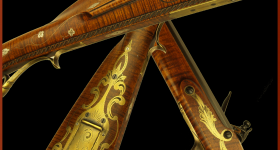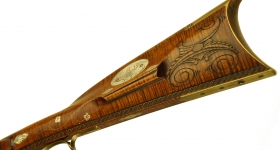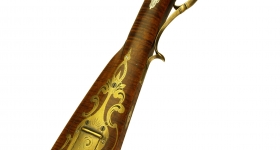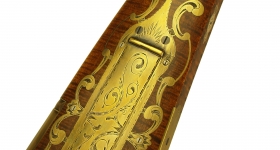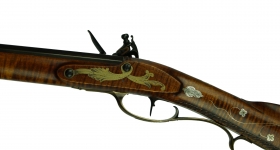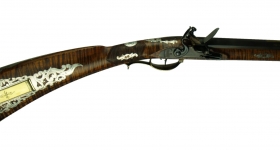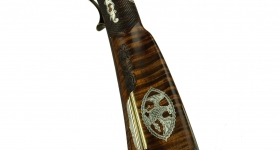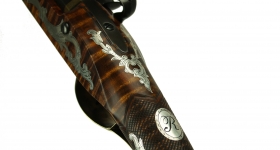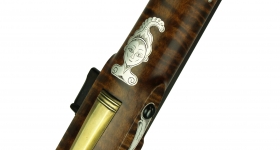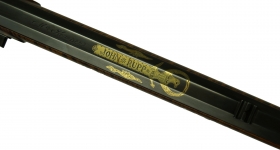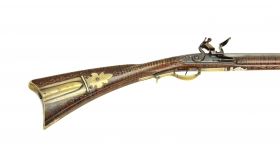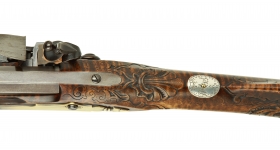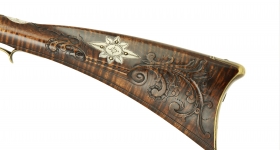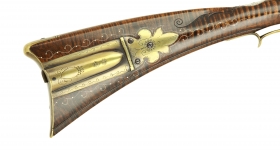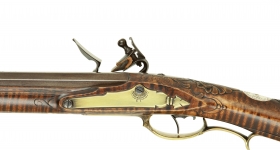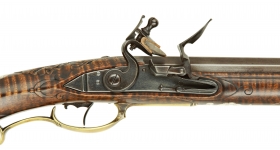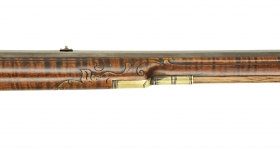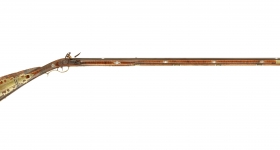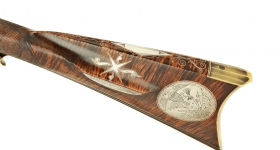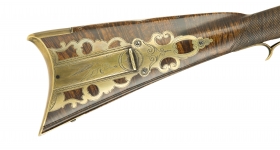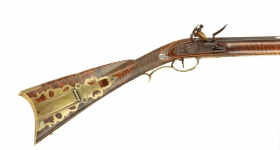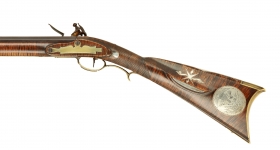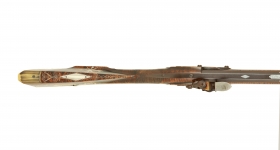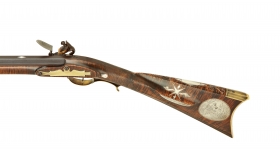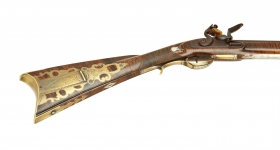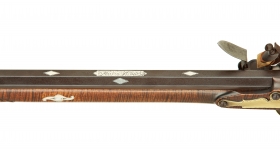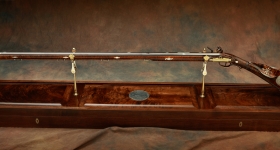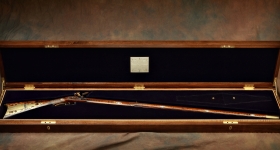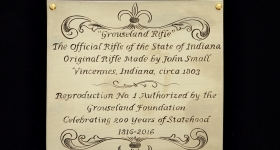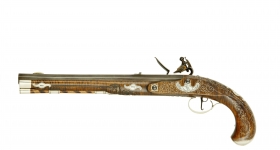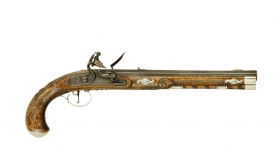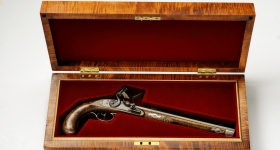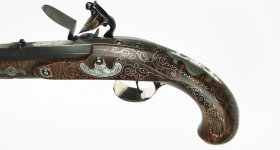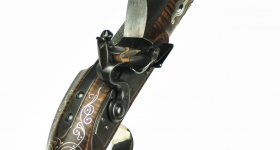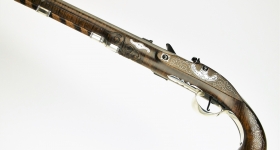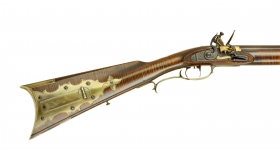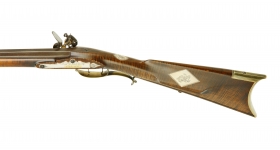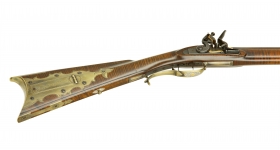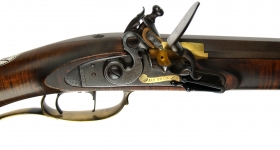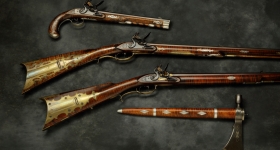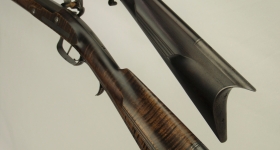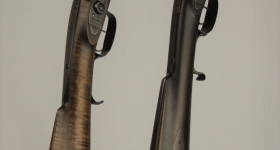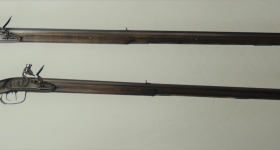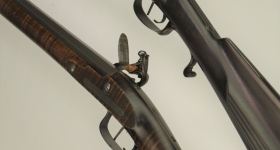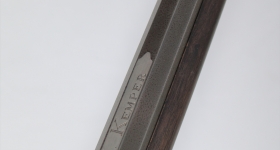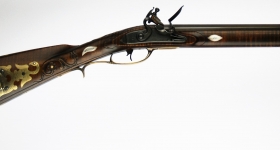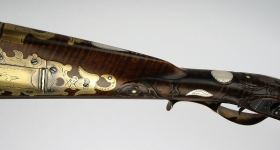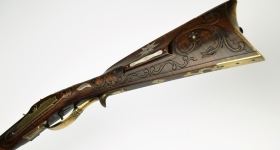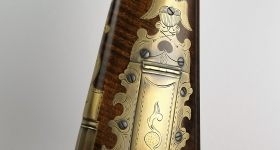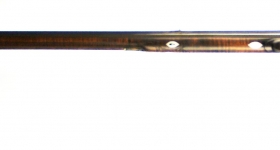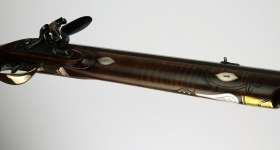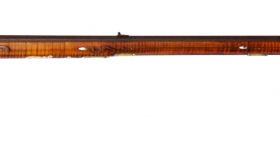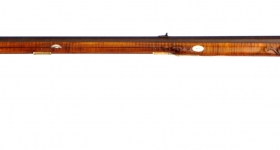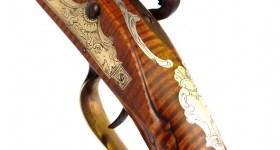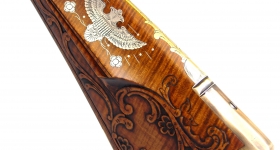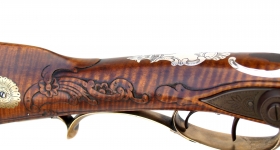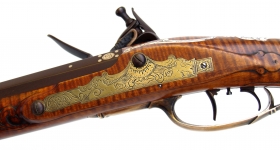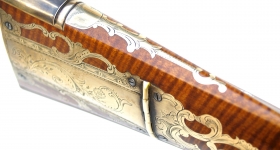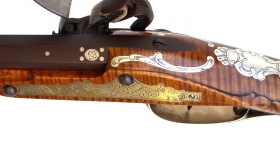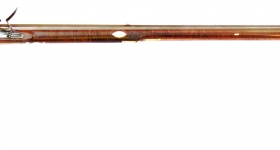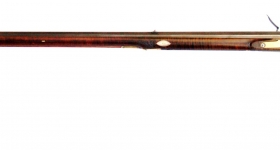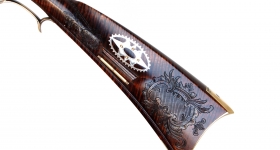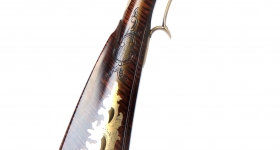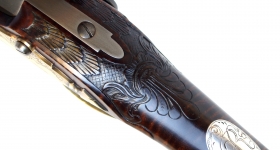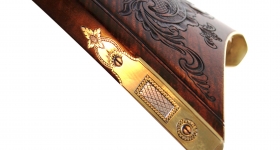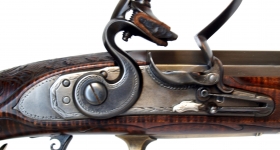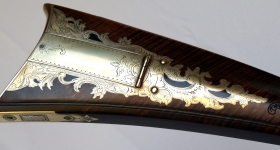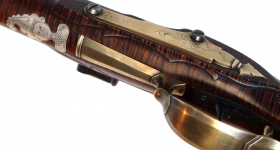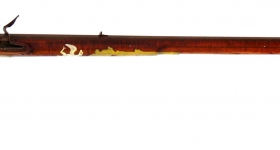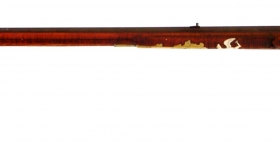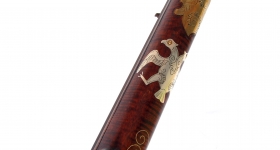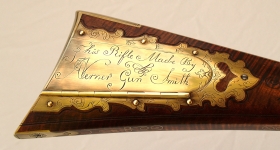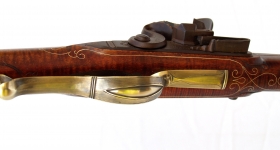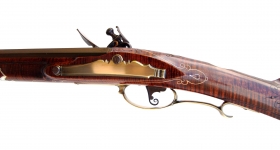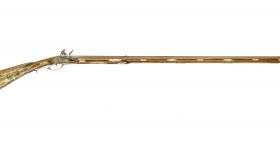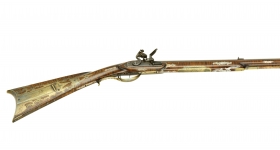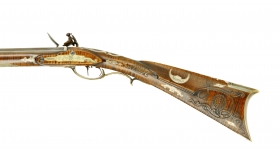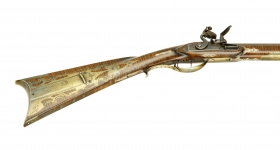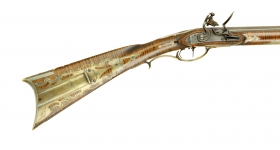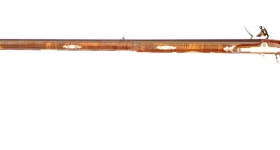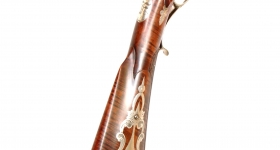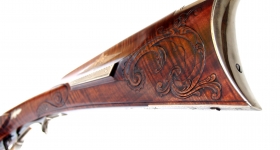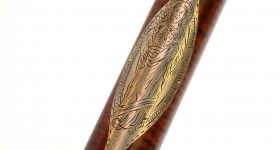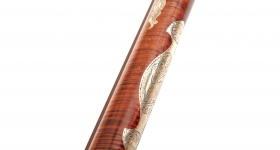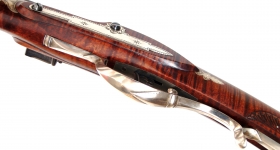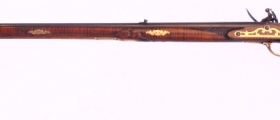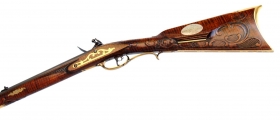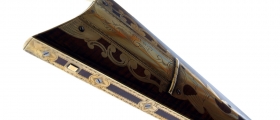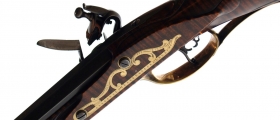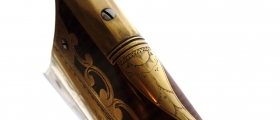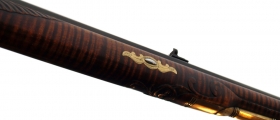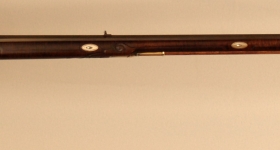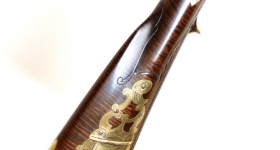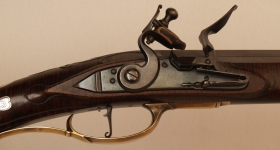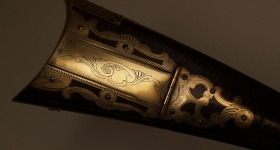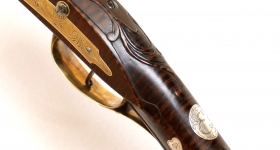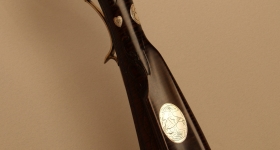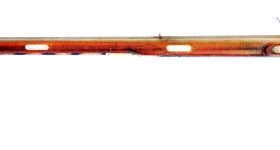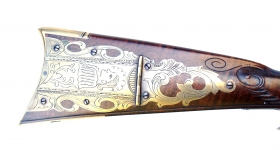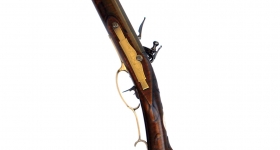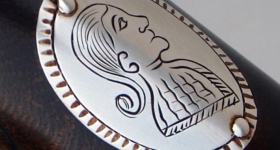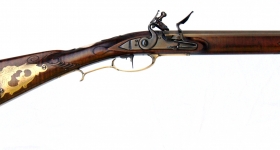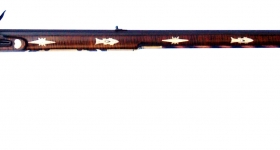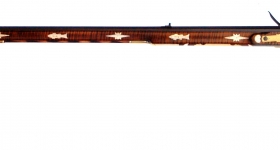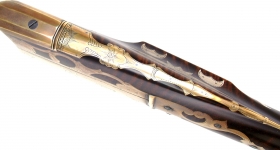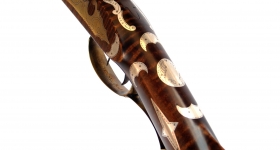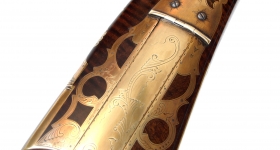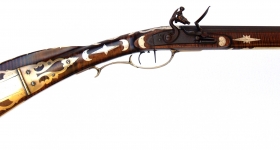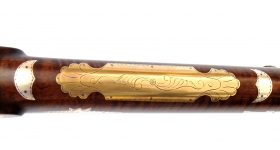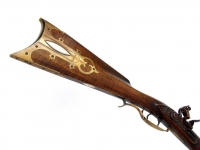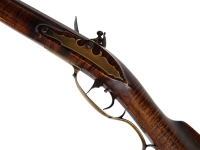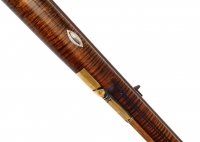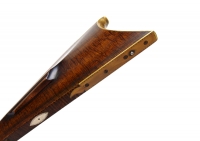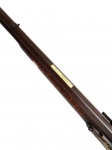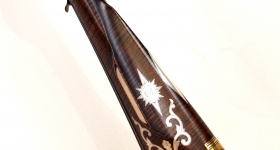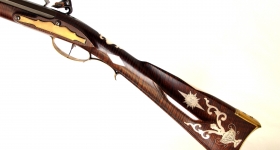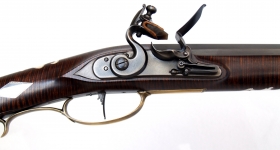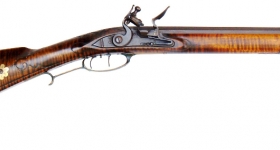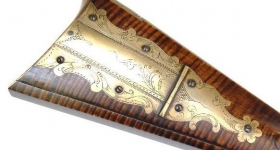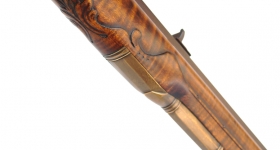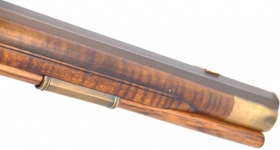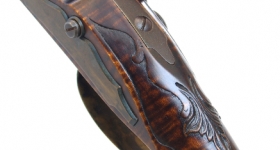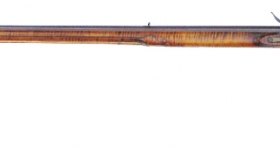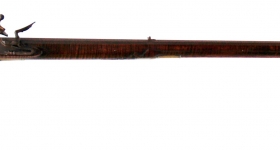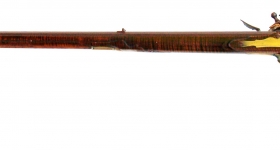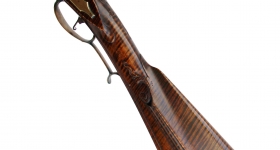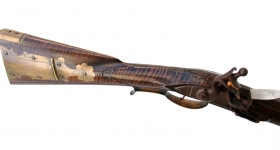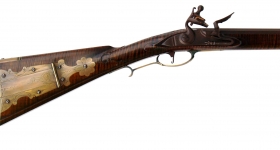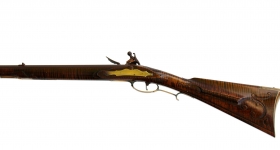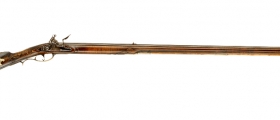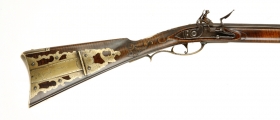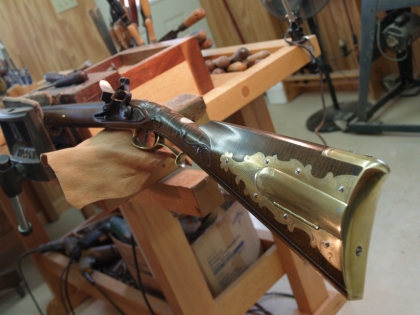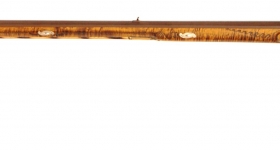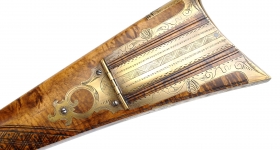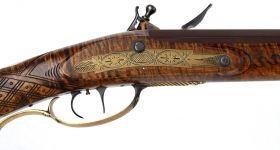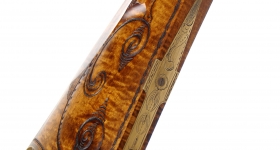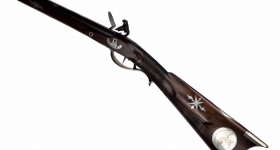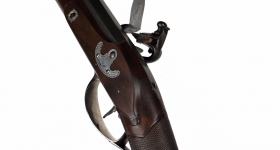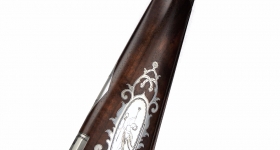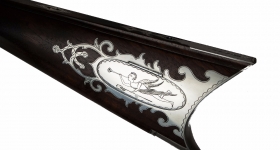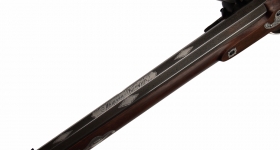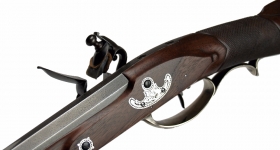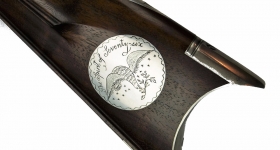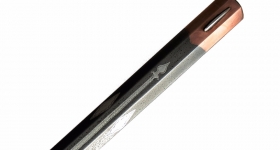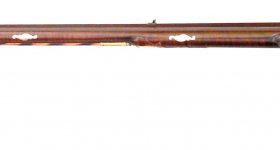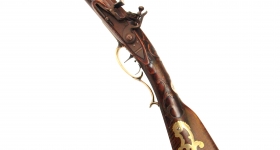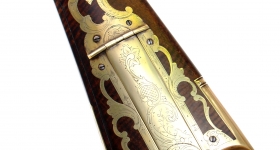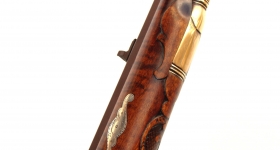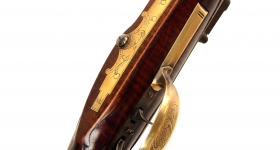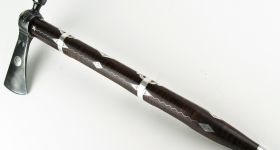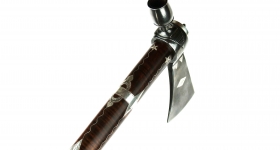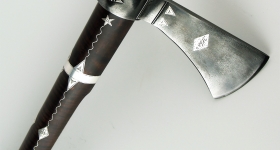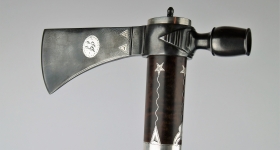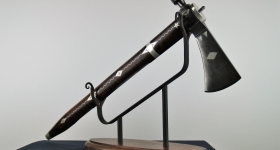Allegheny County (John Fleeger) - This classic Western Pennsylvania rifle is patterned after the work of John Fleeger and exhibits many of the characteristics found on the finer rifles from that region. Fleeger apprenticed under Thomas Allisson, who was one of the true masters of Western Pennsylvania gunmaking. This rifle includes a combination of silver and brass elements. The most notable embellishments include the bold and highly pierced Manongahela Valley patchbox, C-scroll carving and the distinctive slash-and-scoop buttstock moulding.
Photography by: Marvin Kemper
_____________________________________
Lehigh Valley (John Rupp II) - This rifle is patterned after the work of John Rupp II (1786-1848) who worked in Weisenburg Township, Lehigh County, Pennsylvania from 1812 to 1848. Often referred to as “John Rupp the younger” he is the nephew of the renowned Lehigh Valley gunmakers, Adam Herman Rupp and Johannes Rupp. His worked represents the pinnacle of the late flint era of gunmaking and shows many similarities to that of Jacob Kuntz. This rifle is heavily embellished in sterling silver and includes an ornate brass inlay barrel signature motif.
_____________________________________
Lehigh Valley (Herman Rupp) - This rifle features classic Lehigh lines, including a wide wrist, sheathed upper buttplate extension and extensive carving. It is patterned after the well-documented work of Herman Rupp.
Photography by: Ric Lambert Studio
_____________________________________
Grouseland Rifle Reproduction (John Small) - This rifle is a precise reproduction of the Official Indiana State Rifle, also known as the “Grouseland Rifle.” The original rifle, pictured next to the reproduction, was built by Col. John Small of Vincennes, Indiana (circa 1803). The 2016 project was authorized by the Grouseland Foundation (Daughters of the American Revolution) from Vincennes, to commemorate Indiana’s bicentennial (1816-2016). The original Grouseland Rifle is on permanent display inside the Grouseland mansion/museum in Vincennes. It is the former home of William Henry Harrison, the Governor of the Indiana Territory, a national war hero and later the ninth President of the United States.
Photography by: Ric Lambert Studio
_____________________________________
Pierre Menard Pistol Reproduction (John Small) - Patterned after a pistol made by John Small of Vincennes, Indiana for the renowned eighteenth century fur trader, Pierre Menard (circa 1798), this .50 caliber pistol was built from a select piece of curly maple and includes a swamped barrel. It is mounted entirely in sterling silver and includes extensive silver wirework.
Photography by: Marvin Kemper
_____________________________________
Cumberland River Valley, Tenn. (Jacob Young) - Renowned for the elegance and simplicity of his rifles, Jacob Young was a true master of gunmaking in the Cumberland River Valley. This was during a time when most rifles exhibited utilitarian and “blacksmithy” characteristics. This reproduction is patterned after the Jacob Young rifle built for William Wade Woodfork of Jackson County, Tennessee (circa 1815). It features a captured lid patchbox and is embellished with brass, sterling silver and fine gold. The customized flintlock includes a handmade double-throated cock and includes a gold-lined pan.
Photography by: Ric Lambert Studio
_____________________________________
Tennessee Rifles (Iron Mounted) - These rifles represent the classic east Tennessee styling as produced by the likes of Ambrose Lawing and Baxter Bean. It was common to see these “blacksmithy” rifles built in both walnut and curly maple. Barrel lengths were often quite long as the pictured rifles include barrel lengths of 46″ and 48″. All mounts and hardware are hand-forged in steel.
Photography by: Marvin Kemper
_____________________________________
Lebanon County (Nicholas Beyer) - Considered by noted author, Joe Kinding, Jr. to be one of the premier craftsman of the Kentucky longrifle, Nicholas Beyer was known for his unique styling. Most notable was his use of Pennsylvania Dutch motifs. This rifle is patterned after one of Beyer’s finest works (circa 1810).
Photography by: Marvin Kemper
_____________________________________
Franklin Co. (John Noll #1) - This rifle is patterned after the work of the renowned eighteenth century gunmaker, John Noll. He is celebrated as one of the most artistic gunsmiths of the Golden Age of the Kentucky rifle. Like the original, this rifle has a blond finish that compliments the assortment of finely engraved silver and brass accents.
Photography by: Marvin Kemper
_____________________________________
Lehigh Valley (Jacob Kuntz) - This rifle features classic Lehigh details, including a wide wrist, sheathed upper buttplate extension and extensive carving. It is patterned after the well-known Jacob Kuntz rifle on display at the Metropolitan Museum in New York City.
Photography by: Marvin Kemper
_____________________________________
Bucks County (Andrew Verner) - This rifle is a replica of perhaps the most well-known surviving rifle from Bucks County, Pennsylvania. Andrew Verner was a master of the unique Bucks Co. style. This piece exhibits the distinctive stock architecture, side opening patchbox, ornate entry pipe and decorative wire inlay. It is finished in a violin red finish consistent with the vintage rifle.
Photography by: Marvin Kemper
_____________________________________
Westmoreland Co. (George Kettering) - This rifle exhibits the “Golden Age” of gunmaking in its most fully evolved state. It is patterned after the work of the renowned Westmoreland County gunmaker, George Kettering. The 40 caliber rifle features twenty-nine sterling silver inlays and bold relief carving. The large Monongahela Valley patchbox was typical to the more elaborate rifles made in this region.
Photography by: Ric Lambert Studio
_____________________________________
Westmoreland Co. (David Morton) - This rifle exhibits the classic Western Pennsylvania style of gunmaking. It is patterned after the work of the region’s finest gunsmith, David Morton. This 36 caliber rifle is mounted in all German Silver and features Morton’s large Monongahela Valley patchbox.
Photography by: Marvin Kemper
_____________________________________
York Co. (Frederick Sell) - This rifle is a reproduction of perhaps the finest rifles ever built by this highly regarded Golden Age gunsmith. It features a number of pierced inlays and Sell’s unique style of relief carving. The distinctive brass vent pick holder with the chevron filings and decorative flush sideplate give an added character to this piece.
Photography by: Marvin Kemper
_____________________________________
York Co. (Frederick Sell #2) - This rifle is classic “Littlestown, PA.” It includes Frederick Sell’s most recognized patchbox design, as well as his unique style of relief carving and engraving. A brass nameplate is inset into the top barrel flat, as this was common on F. Sell rifles.
Photography by: Marvin Kemper
_____________________________________
York Co. (Frederick Sell #3) - This rifle is patterned after the work of Littlestown, Pennsylvania gunsmith, Frederick Sell. It projects the typical “Sell” carving and engraving style. Unique to this rifle are the silhouettes of what some consider to be George Washington. These are found on the patchbox lid and silver thumb inlay.
Photography by: Marvin Kemper
_____________________________________
Upper Susquehana (John Dreisbach Sr.) - John Dreisbach worked in Mifflenburg, Union County, Pennsylvania. This rifle is a copy of the so-called “JD” rifle pictured in Joe Kindig Junior’s “Thoughts on the Kentucky Rifle in its Golden Age.” It includes forty-seven Sterling Silver and brass inlays, as well as the distinctive Upper Susquehana style of incised carving.
Photography by: Marvin Kemper
_____________________________________
The Lexington Rifle – This rifle is a copy of an original by William Turner Bryan (circa 1815). It is typical of the work done by the family of Bryan gunsmiths and features the distinctive two-piece Lexington patchbox. The rifle was built as a donation to the Contemporary Longrifle Foundation’s 2013 live auction in Lexington, Kentucky.
Photography by: Mark Elliott Photography
____________________________________
John Small, Vincennes, Indiana “Urn Rifle” - John Small (1768-1821) was not only an accomplished gunsmith, but he was also the first sheriff of what would become the State of Indiana, a militia captain, tavern-keeper, ferry operator, territorial legislator, silversmith and artist of the highest caliber. The official seal of the State of Indiana was designed by John Small. This rifle is patterned after his distinctive “urn rifle.” The rifle includes a number of sterling silver inlays that in John Small’s time were obviously influenced by the French heritage of Vincennes, Indiana. The double fleur-de-lis inlay on the wrist can be found on most all of Small’s surviving arms. The bold silver urn is believed to be of masonic significance and symbolized the keeping of the temple builder’s ashes. This rifle was commissioned by the National Rifle Association as a presentation piece for the 2014 Convention in Indianapolis, Indiana.
Photography by: Marvin Kemper
_____________________________________
Early Lancaster (Jacob Dickert) - Built in the style of Jacob Dickert, this rifle exhibits the classic characteristics of many early Moravian period rifles. Numerous other gunsmiths such as William Antes, Andreas Albrecht and Jacob Graef utilized similar stock architecture.
Photography by: Marvin Kemper
_____________________________________
Early Lancaster (Jacob Dickert #2) - This rifle exhibits architecture very similar to the other early Lancaster. However, it is an earlier version of Jacob Dickert’s work with its large Germanic flintlock and bold “daisy head” patchbox.
Photography by: Marvin Kemper
_____________________________________
Lancaster (Henry Albright) - This rifle displays the typical “straight comb” architecture of the Lancaster School of gunmaking. It is patterned after a Henry Albright original and features his distinctive “double dove” patchbox. The design of the relief carving and cheek inlay are by Marvin Kemper. This rifle includes an aged barrel and lock. These steel components are slightly pitted and finished with a grey coloration. This finish and rust browning are available on all my rifles. If desired, I can also create a somewhat more radical or mottled look as you can see on the Henry Albright rifle.
Photography by: Rick Lambert Studio
_____________________________________
Lancaster (Jacob Dickert #3) - This is a left-handed reproduction of Dickert’s rifle featuring the daisy head patchbox with the domed side-opening lid.
Photography by: Marvin Kemper
____________________________________
Lancaster (Melchior Fordney) - This rifle is patterned after the work of the prolific Lancaster, Pennsylvania gunmaker, Melchior Fordney. The rifle is a 62 caliber smooth rifle and exhibits Fordney’s classic style of wrist checkering and deep cut engraving.
Photography by: Marvin Kemper
_____________________________________
John Small, Vincennes, Indiana “William Clark Rifle” - John Small (1768-1821) was not only an accomplished gunsmith, but he was also the first sheriff of what would become the State of Indiana, a militia captain, tavern-keeper, ferry operator, territorial legislator, silversmith and artist of the highest caliber. He provided arms for a number of notable customers, including William Clark of the “great expedition.” This petite rifle is patterned after the petite half-stock rifle made for Clark (circa 1807). It is stocked in walnut and features embellishments in sterling silver. The muzzle includes Small’s trademark “copperhead” cladding.
Photography by: Marvin Kemper
_____________________________________
Franklin Co. (John Noll #2) - This rifle is patterned after the work of the renowned gunmaker, John Noll. He is celebrated as one of the most artistic gunsmiths of the Golden Age of the Kentucky rifle. His beautiful engraving set his work apart from many others.
Photography by: Marvin Kemper
_____________________________________
John Small, Pipe Tomahawk - Pictured here is a collage of my work. Included is a reproduction of one of John Small’s typical pipe tomahawks. Small was working in Vincennes during a time when relations with the Shawnee, Miami and other tribes were vital to the well-being of those living in this frontier outpost. Perhaps his tomahawks were used as “tokens of good will.” This pipe tomahawk is embellished entirely in sterling silver and includes and hand-forged head.
Photography by: Ric Lambert Studio
_____________________________________
John Small, Pipe Tomahawk (Meriwether Lewis) - This is a reproduction of a pipe tomahawk done for the renowned explorer Meriwether Lewis. The original is attributed to the work of John Small of Vincennes, Indiana. This pipe tomahawk is embellished entirely in sterling silver and includes a hand-forged head.
Photography by: Marvin Kemper
_____________________________________
